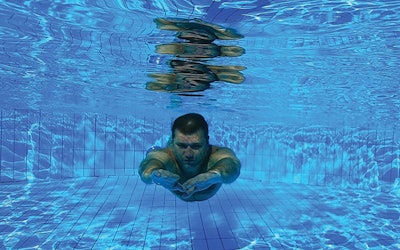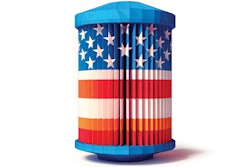
What's the first thing that pops into your mind when you think of a YMCA pool? If it's not piercing lifeguard whistles or the echoing laughter of children, chances are you thought of the smell. Most people call it a "chlorine" smell, but pool pros know it's really caused by chloramines.
Keith Williams is vice president of facilities and properties for the YMCA of Boulder Valley, situated at the base of Colorado's Rocky Mountains. So he knows all about that smell. Six years ago, one of the four locations he manages was getting a brand-new pool, and Williams decided it was a good time to try a brand-new approach to water purification and sanitization — one that might do something about the air quality.
"I put a UV system on it and it was wonderful. The water was clean and clear. Just beautiful," he says. "The only thing is it was also expensive because of the maintenance and the need to change out the $1,000 bulbs."
So in 2015, when another Y pool needed a new sanitization system, Williams figured he'd try to find a less-costly alternative to the UV. He'd already tried ozone years before, but found the water it delivered, while clear and free of harmful microorganisms, wasn't worth the considerable price tag, either.
A bit of research led him to a local manufacturer called Clear Comfort, makers of a device that promised to combine the benefits of both ozone and UV without the high costs associated with them.
"Now, I've been in the profession a long time — 36 years — and I'm not someone who's just going to jump at the new thing just because it's new," Williams says. "But when I think something will work, I'll take the calculated risk and try it."
He and Clear Comfort agreed on a 90-day trial period in one of his older, smaller pools, where chloramines clogged the air and the water quality was merely "normal," according to Williams.
After three months of treatment with Clear Comfort's "advanced oxidation processing," Williams says he was "shocked" by the water's clarity, "but even more shocked at what it did to the air.
"The air quality is much like a UV system — no chloramines. So after the three-month trial I left it on and discovered that it also greatly reduced our chlorine usage."
By his estimation, the Y is using 34 percent less chlorine than it did before switching to AOP. "There are some growing pains with a new system, but once we get more used to this I expect those savings will go up," he says.
These outcomes jibed nicely with a goal Williams and the pool industry at large share: sanitizing and oxidizing water while reducing chemical usage. It's that goal that gave rise to the broad category of "alternative sanitizers," which includes the ozone and UV systems Williams previously used in the pools he managed.
Chemistry Class
In explaining advanced oxidation processing, something that begins by creating ozone, Clear Comfort's president Steve Berens prefaces his remarks with a point:
"Because of the way we use oxygen, people get confused and think we're an 'ozone generator.' But really, the only thing that's similar between us and a traditional ozone generator is the way we inject treated air into the water. Past that, the chemistry is completely different, and we're a lot more effective."
In simplest terms, an AOP system introduces ozone into the water and zaps it with germicidal UV light to create hydroxyl radicals. These hydroxyl radicals are short-lived but powerful oxidizers. The goal is to produce these hydroxyl radicals in huge amounts.
Again, Berens is careful to distinguish AOP from simple ozone generation. "When you just inject ozone (O3) into the water, it sheds an oxygen singlet into the water," Berens explains (careful to keep the conversation at the Chem 101 level for the writer and readers). "When it does that it creates a single hydroxyl radical, leaving the hydroxide.
With the additional steps of the AOP process, that single oxygen atom shed from ozone ends up creating two hydroxyl radicals, Berens says. So in addition to doubling the hydroxyl radicals produced by each oxygen singlet making the sanitizer more powerful, AOP requires about one-third the oxygen of an ozone generator.
"Put another way, the AOP device is a hydroxyl-creation machine. That's our sole purpose," Berens says. "And because of that, we create a decent amount of hydrogen peroxide as a residual. It's not enough to sanitize the water by itself, but it's enough to help out."
Berens says AOP and the hydrogen peroxide it creates can get a pool up to 95 percent chlorine-free during the peak of the season. This has been one of the device's key selling points.
"Hydrogen peroxide is more oxidative than chlorine," he says. "Generally the response we get is that, 'We've got much better water clarity, and when that algae comes we can get rid of it quickly so homeowners can get back to swimming in a pool without chlorine.'
"It's a very positive effect. There aren't any byproducts such as chloramines associated with it. Those are all from halogen-based chemicals such as chlorine and bromine."
The Y's Williams says the difference in air quality with AOP on the Boulder pool was so improved, he decided to add it to another pool, this one in nearby Longmont. A month in, the impact has been similarly dramatic.
"The air quality is great, the water is crystal clear and silky," he says. "Everyone loves it, and I've become a big supporter of these systems. Not only do they cost less to run than UV, but they really do deliver the same results."
Backyard Biocide
While commercial clients like Williams and his YMCAs represent an important segment of Clear Comfort's target audience, most of the company's customers have been residential. Dustin Watters, a third-generation pool professional, has been selling them to homeowners in the Las Vegas area, many of whom wish to cut their chlorine usage.
"People start to ask me about alternative sanitizers and I ask them what it is they're looking for," he says. "Mostly it revolves around salt and the chlorine generators. That's what people hear about and that's what they ask me about.
"They'll say they have a sensitivity to chlorine, and that they want to eliminate it, but of course salt generators make chlorine. So they don't really know what they're talking about. You're still making chlorine!"
After clearing misconceptions about salt pools and chlorine, Watters gauges each customer's comfort level with investing in equipment, their willingness to adhere to the maintenance schedule he sets for them, and their expectations. With a full customer understanding of what the different sanitizing technologies actually provide, he is ready to move forward.
Another pool pro, Alan Butters, owner of Watersaver Leak Detection in St. Charles, Ill., has similar ideas about what kind of customer is right for advanced oxidation processing. Homeowners that aren't good at taking care of a traditional chlorine pool, he explains, aren't going to be any better with AOP.
"It does simplify pool maintenance, but it's not a cure-all," Butters says. "It just replaces chlorine as the biocide. So, if you're already on a program that includes chlorine, you're only replacing that one leg, and you'll still need to use an algaecide and to oxidize periodically with shock."
Once a customer is sold on the idea, and has proper expectations, Butters says the actual installation is a snap, especially if the pool is already using a salt generator.
"I just remove the salt generator and drop in the manifold," he says. He just takes the old salt generator control box off the wall and connects the new system to the existing circuit, and the system is ready to go.
"Sometimes a salt cell will fail and pool owners won't replace them, so they've just got a useless piece of equipment in the line. I target this kind of customer," Butters says, because the conversion is easy.
Faithful Followers
Butters is a true believer in AOP and, like everyone cited in this story, he uses an AOP system on his own backyard pool.
He describes the water as being unlike anything else he's experienced in a swimming pool. The water looks better, and feels like "fresh water," he says. In addition to being easy on the eyes and skin, it's very easy on pool equipment.
"There are no issues with corrosion, which is huge, and no longer do I have the issue of over/under chlorination like I did with my old salt system," he says. "When the automatic safety cover on my pool was closed, I would need to turn the output down to 20 percent, but then if the cover was left open and we were swimming I had to raise the output to 60 to 80 percent.
"With the [AOP] system, I only need to keep my filter clean and maintain the flow rate. I can leave town, leave the cover closed and the pool unattended for a couple weeks at a time without any worries of a wrinkled liner or toasted cover fabric."
Comments or thoughts on this article? Please e-mail [email protected].







































